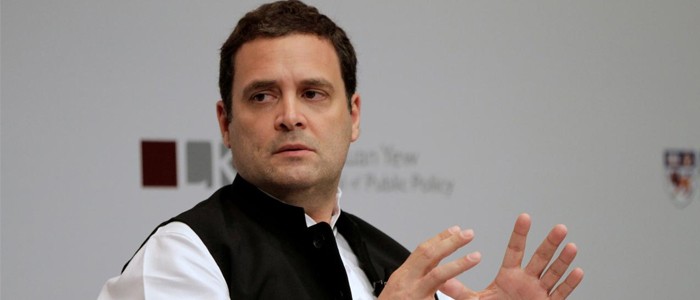
Finally a peep into Rahul Gandhi’s leadership style of functioning. In selecting three chief ministers for Madhya Pradesh, Rajasthan and Chhattisgarh, he has shown healthy regard for constructive dissent, experience and organisational commitment.
In Madhya Pradesh and Chhattisgarh, he has chosen state unit presidents. Both Kamal Nath and Bhupesh Baghel had toiled hard and fought an epic battle against 15 years of BJP rule.
The uneasiness in the selection of Ashok Gehlot in Rajasthan and, to a lesser extent, Baghel in Chhattisgarh showed a redeeming side of Rahul. Unlike his when his father and grandmother were heading Congress, Rahul displayed his knack to play it by the ear, a rarity in all-imposing ‘high command’ structure of the grand old party.
At one level, it gave an impression that Rahul was not in command when some enthusiastic Gujjar leaders exhibited the ugly face of lawlessness, stopping trains and burning vehicles. The AICC chief sought to send out a subtle message even as regional, linguistic and caste-based aspirations and lobbying were alive. He kicked in a ‘vibrant’ political party as against the “two-person rule” on the other side of the political spectrum. Whether these optics find any resonance in political discourse in the run-up to 2019 elections is something that remains to be seen.
Just like the much-written-about story of ‘magician’ Ashok Gehlot’s rise and rise in politics, Bhupesh Baghel’s journey to the top job in Raipur is equally fascinating. A young Bhupesh was pursuing B.Sc when he began losing interest in studies. His father Nand Kumar Baghel made his son an offer — he could quit studies in exchange for the promise that he would become the chief minister of the state one day. Baghel Jr. did not hesitate even for a second and took up the challenge. The scientific world’s loss was the political sphere’s gain, more precisely the Congress’ gain.
Baghel, 57, has not looked back since. His journey was arduous. The web of NSUI and Youth Congress hierarchy is such that only a handful make the cut to the parent organisation. What perhaps may have caught Rahul’s eye was Baghel’s uncompromising attitude towards the interest of the party. In 2015-16 when an audio tape purportedly revealed that the Antagarh Assembly seat bypoll in 2014 was fixed, Baghel, as head of Chhattisgarh Congress, acted swiftly and expelled Ajit Jogi’s son, Amit Jogi, from the party. Jogis were powerful players in Delhi Congress durbar, but Baghel remained adamant and somewhat convinced Rahul about the Jogis often acting as ‘B-Team’ of the then BJP chief minister Raman Singh.
The state retaliated. In September this year, the Central Bureau of investigation (CBI) filed a chargesheet in a special court in Raipur against Baghel, his close aide and journalist Vinod Verma and three others in a sex CD case.
Baghel took a Gandhian path, refusing to opt for bail. The state party chief remained in judicial custody for a couple of days even as his rivals within the party tried to convince Rahul to get rid of a ‘tainted’ person. But Rahul trusted Baghel and extended all help. Rahul believed Baghel’s claim that both the CBI and Raman Singh were acting against him as part of a political witch-hunt.
Interestingly, Baghel insists that throughout Raman Singh’s tenure, he did not share dais with the chief minister or shook hands with him even once. While some may question this rather bizarre inflexibility on grounds of being contrary to norms of civility and parliamentary ethics, his stand is part of Congress folklore in Chhattisgarh.
In Bhopal, Chief Minister Kamal Nath is set to start with a big bang. On the day of his oath-taking ceremony, Nath plastered the city with over 50,000 hoardings, banners, posters and cut-outs.
What was striking was a smiling portrait of Sanjay Gandhi in the gallery of Indira-Rajiv, Sonia and Rahul Gandhi as revered leaders of the party. The inclusion of Sanjay is significant on several counts. The younger son of Indira was heir-apparent, towering figure until his abrupt death in June 1980. The void led to a bitter power struggle within the Indira household that saw Sanjay’s widow Maneka on one side and Rajiv and Sonia on the other. Rajiv won the day and Maneka was forced to move out from Indira residence in the dead of the night with infant Feroze Varun Gandhi.
The traumatic saga saw many Congress leaders avoiding any public display of affection towards the late Sanjay Gandhi. But Nath has been an exception. His New Delhi house at January 30, Tuqlaq Marg has a prominent portrait of Sanjay Gandhi, mounted on a wall where visitors have one-on-one interactions with Nath.
The streak of independent thinking, his ability to acknowledge those who helped him and remember them with élan is something that is part of Nath’s personality. As the chief minister of Madhya Pradesh, Nath is all set to be an unconventional chief minister who understands the importance of cash and delivery. Nath may start showing results faster than expected.
Ashok Gehlot may lack Nath’s flamboyance and good taste, but the streak of independence and impeccable loyalty towards Nehru-Gandhi family has been a hallmark of Gehlot who has been Gandhian, a teetotaller, vegetarian and early riser throughout his adult life. Unlike Nath and Baghel, Gehlot has a bigger task cut out for him as he has to accommodate Sachin Pilot, his deputy at the secretariat, in Jaipur.
Pilot enjoys Rahul’s trust and is guided by an ambition to move up and fast. The magician in Gehlot has to come up with a trick or two to keep Pilot in good humour until at least 2019 Lok Sabha elections and ensure that the party wins bulk of parliamentary seats. But then, managing contractions has been easy meat for Gehlot.


.jpeg)

